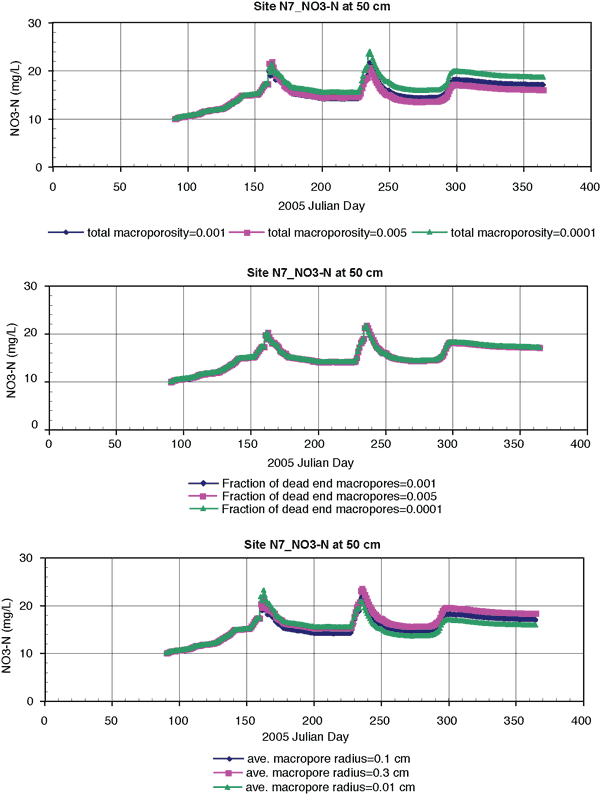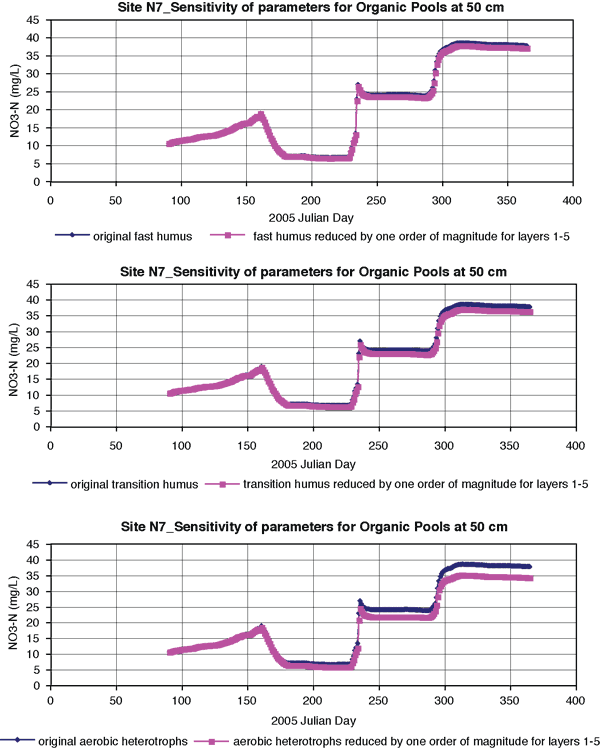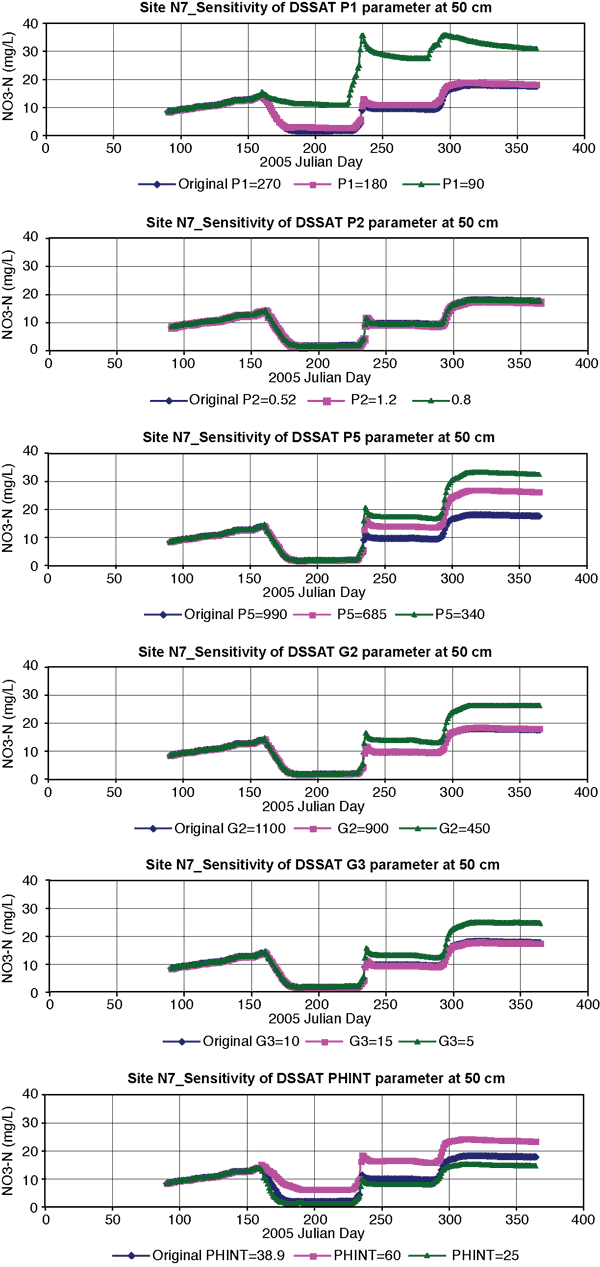Kansas Geological Survey, Current Research in Earth Sciences, Bulletin 258, part 1
Prev Page--Results and Discussion
![]()
![]()
![]()
Kansas Geological Survey, Current Research in Earth Sciences, Bulletin 258, part 1
Prev Page--Results and Discussion
![]()
The analysis carried out in this report leads to the following conclusions:
Adopting such reduced-N application measures would definitely reduce the size of residual nitrate stored in the thick vadose zone in the area and slow down its downward migration. Combining such measures with a crop rotation that includes alfalfa should further reduce the amounts of residual nitrate in the soil.
This study was funded by the U.S. Geological Survey through the Kansas Water Resources Institute. Numerous people and agencies assisted us during the conduct of this study: Dr. Jay Jabro, research soil scientist with USDA-ARS Sidney, Montana, and Dr. Saseendran Anapalli, crop scientist with USDA-ARS, Fort Collins, Colorado, provided detailed and constructive comments that helped to improve this manuscript. Dr. L. R. Ahuja, Research Leader, Agricultural Systems Research Unit, USDA-ARS, Fort Collins, Colorado, provided useful comments on an earlier version of this manuscript and shared his insights on macropore flow. Kansas NRCS personnel J. Warner, S. Graber, R. Still, T. Cochran, and C. Watts assisted us with field characterization and soil-property lab analyses through the National Soils Laboratory in Lincoln, Nebraska. NRCS Soil Mechanics Laboratory in Lincoln, Nebraska, performed saturated hydraulic conductivity and related analyses. Dr. T. Willson and other personnel from the Garden City Experiment Station, Kansas State University, assisted us with neutron-probe readings and related analyses. D. Schuette of Servi-Tech assisted us with coring, sampling, and dye-tracer experiments. W. McCall of Geoprobe Systems assisted us with the Geoprobe equipment during field-site installations. The farmer-operator of the field sites C. Nicholson and his office personnel assisted us with land-use information and access to the sites. K. Rojas of NRCS at Fort Collins, Colorado, assisted us with the RZWQM. Numerous other personnel from OMI and KGS assisted us at different stages of this project. Finally, our KGS colleagues Jim Butler, Marla Adkins-Heljeson, and Mark Schoneweis provided useful review comments, edited the manuscript, and perfected the figures, respectively.
Abrahamson, D. A., Radcliffe, D. E., Steiner, J. L., Cabrera, M. L., Hanson, J. D., Rojas, K. W., Schomberg, H. H., Fisher, D. S., Schwartz, L., and Hoogenboom, G., 2005, Calibration of the Root Zone Water Quality Model for simulating tile drainage and leached nitrate in the Georgia Piedmont: Journal of Agronomy, v. 97, p. 1,584-1,602.
Ahuja, L. R., and Williams, R. D., 1991, Scaling of water characteristic and hydraulic conductivity based on Gregson-Hector-McGowan approach: Soil Science Society of America, Journal, v. 55, p. 308-319.
Ahuja, L. R., DeCoursey, D. G., Barnes, B. B., and Rojas, K. W., 1993, Characteristics of macropore transport studied with the ARS Root Zone Water Quality Model: American Society of Agricultural Engineers, Transactions ASAE, v. 36, no. 2, p. 369-380.
Ahuja, L. R., Rojas, K. W., Hanson, J. D., Shaffer, M. J., and Ma, L., eds., 2000, Root Zone Water Quality Model--Modeling management effects on water quality and crop production: Water Resources Publications, LLC, Highlands Ranch, CO, 372 p.
Ahuja, L. R., and Ma, L., 2002, Parameterization of agricultural system models--Current approaches and future needs; in, Agricultural System Models in Field Research and Technology Transfer, L. R. Ahuja, L. Ma, and T. A. Howell, eds.: Lewis Publishing, p. 273-316.
Bond, W. J., 1998, Effluent irrigation--An environmental challenge for soil science: Australian Journal of Soil Research, v. 36, no. 4, p. 543-555.
Broadbent, F. E., Rauschkolb, R. S., Lewis, K. A., and Chang, G. Y., 1980, Spatial variability of nitrogen-15 and total nitrogen in some virgin and cultivated soils: Soil Science Society of America, Journal, v. 44, p. 403-432.
Brooks, R. H., and Corey, A. T., 1964, Hydraulic properties of porous media: Colorado State University, Fort Collins, CO, Hydrologic Paper 3.
Bruce, B. W., Becker, M. F., Pope, L. M., and Gurdak, J. J., 2003, Ground-water quality beneath irrigated agriculture in the Central High Plains aquifer, 1999-2000: U.S. Geological Survey, Water-Resources Investigations Report 03-4219. [available online]
Cameira, M. R., Fernando, R. M., Ahuja, L. R., and Ma, L., 2007, Using RZWQM to simulate the fate of nitrogen in field soil-crop environment in the Mediterranean region: Agricultural Water Management, v. 90, p. 121-136.
Celia, M. A., Bouloutas, E. T., and Zarba, R. L., 1990, A general mass-conservative numerical solution for the unsaturated flow equation: Water Resources Research, v. 26, p. 1,483-1,496.
Dodge, D. A., Tomasu, B. I., Haberman, R. L., Roth, W. E., and Baumann, J. B., 1965, Soil survey Ford County, Kansas: U.S. Department of Agriculture, Soil Conservation Service, Series 1958, no. 32, 84 p.
Dogan, E., Clark, G. A., Rogers, D. H., Martin, V., and Vanderlip, R. L., 2006, On-farm scheduling studies and CERES-Maize simulation of irrigated corn: Applied Engineering in Agriculture, v. 22, no. 4, p. 509-516.
Flury M., Fluhler, H., Jury, W. A., and Leuenberger, J., 1994, Susceptibility of soils to preferential flow of water--A field study: Water Resources Research, v. 30, no. 7, p. 1,945-1,954.
Flury, M., and Fluhler, H., 1994, Brilliant blue FCF as a dye tracer for solute transport studies--A toxicological overview: Environmental Quality, v. 23, p. 1,108-1,112.
Flury, M., and Fluhler, H., 1995, Tracer characteristics of brilliant blue FCF: Soil Science Society of America, Journal, v. 59, p. 22-27.
Green, W. H., and Ampt, G. A., 1911, Studies on soil physics; 1--Flow of air and water through soils: Journal of Agricultural Science, v. 4, p. 1-24.
Grossman, R. B., and Reinsch, T. G., 2002, Bulk density and linear extensibility; in, Methods of Soil Analysis, Part 4, Physical Methods, J. H. Dane and G. C. Topp, eds.: Soil Science Society of America, Series No. 5, p. 201-207.
Hanson, J. D., Rojas, K. W., and Shaffer, M. J., 1999, Calibrating the Root Zone Water Quality Model: Journal of Agronomy, v. 91, p. 171-177.
Hanson, J. D., 2000, Generic crop production; in, Root Zone Water Quality Model, L. R. Ahuja et al., eds.: Water Resources Publications, Highland Ranch, CO, p. 81-118.
Heaton, T. H. E., 1986, Isotopic studies of nitrogen pollution in the hydrosphere and atmosphere--a review: Chemical Geology, v. 59, p. 87-102.
Helsel, D. R., and Hirsch, R. M., 2002, Statistical methods in water resources; Chapter A3, Book 4, Hydrologic analysis and interpretation: U.S. Geological Survey, Techniques of Water-Resource Investigations, 510 p. [available online]
Hem, J. D., 1985, Study and interpretation of the chemical characteristics of natural water: U.S. Geological Survey, Water-Supply Paper 2254, 263 p. [available online]
Hoefs, J., 2001, Stable isotope geochemistry, 4th ed.: Springer, 201 p.
Hu, C., Saseendran, S. A., Green, T. R., Ma, L., Li, X., and Ahuja, L. R., 2006, Evaluating nitrogen and water management in a double-cropping system using RZWQM: Vadose Zone Journal, v. 5, p. 493-505.
Kaehler, C. A., and Belitz, K., 2003, Tracing reclaimed water in the Menifee, Winchester, and Perris-South ground-water subbasins, Riverside County, California: U.S. Geological Survey, Water-Resources Investigation Report 03-4039. [available online]
Karamanos, R. E., Voroney, R. P., and Rennie, D. A., 1981, Variation in natural N-15 abundance of central Saskatchewan soils: Soil Science Society of America, Journal, v. 45, p. 826-828.
Kinney, C. A., Furlong, E. T., Werner, S. L., and Cahill, J. D., 2006, Presence and distribution of wastewater-derived pharmaceuticals in soil irrigated with reclaimed water: Environmental Toxicology and Chemistry, v. 25, no. 2, p. 317-326.
Kiniry, J. R., Williams, J. R., Vandelip, R. L., Atwood, J. D., Reicosky, D. C., Mulliken, J., Cox, W. J., Mascagni, H. J., Jr., Hollinger, S. E., and Wiebold, W. J., 1997, Evaluation of two maize models for nine U.S. locations: Journal of Agronomy, v. 89, p. 421-426.
Kozak, J. A., and Ahuja, L. R., 2005, Scaling of infiltration and redistribution across soil textural classes: Soil Science Society of America, Journal, v. 69, p. 816-827.
Kozak, J., Ahuja, L. R., Ma, L., and Green, T. R., 2005, Scaling and estimation of evaporation and transpiration of water across soil texture classes: Vadose Zone Journal, v. 4, p. 418-427.
Kreitler, C. W., 1975, Determining the source of nitrate in ground water by nitrogen isotope studies: Texas Bureau of Economic Geology, Report of Investigations No. 83, 57 p.
LECO Corporation, 1995, Carbon, nitrogen, and sulfur testing in soil/plant tissue: LECO Corporation, St. Joseph, MI, Form # 203-821-002.
Ma, L., Shaffer, J. J., Boyd, J. K., Waskom, R., Ahuja, L. R., Rojas, K. W., and Xu, C., 1998, Manure management in an irrigated silage corn field--Experiment and modeling: Soil Science Society of America, Journal, v. 62, p. 1,006-1,017.
Magesan, G. N., Dalgety, J., Lee, R., Luo, J., and van Oostrom, A. J., 1999, Preferential flow and water quality in two New Zealand soils previously irrigated with wastewater: Journal of Environmental Quality, v. 28, no. 5, p. 1,528-1,532.
Malone, R. W., Ma, L., Ahuja, L. R., and Rojas, K. W., 2001, Evaluation of the Root Zone Water Quality Model (RZWQM)--A review; in, Agricultural Non-point Source Water Quality Models--Their Use and Application, J. E. Parsons, D. L. Thomas, and R. L. Huffman, eds.: Southern Cooperative, Series Bulletin 398, 27 p. [available online]
Mueller, D. K., and Helsel, D. R., 1996, Nutrients in the nation's waters--Too much of a good thing?: U.S. Geological Survey, Circular 1136, 24 p. [available online]
Pachta, C. J., 2007, Improving irrigated cropping systems on the High Plains using crop simulation models: M.S. thesis, Department of Agronomy, Kansas State University, Manhattan, KS, 126 p.
Pettygrove, G. S., and Asano, T., eds., 1985, Irrigation with reclaimed municipal wastewater--A guidance manual: Lewis Publishers, Inc., Chelsey, MI.
Rennie, D. A., Paul, E. A., and Johns, L. E., 1976, Natural nitrogen-15 abundance of soil and plant samples: Canadian Journal of Soil Science, v. 56, p. 43-50.
Ritchie, J. T., Singh, U., Godwin, D. C., and Bowen, W. T., 1998, Cereal growth, development and yield; in, Understanding Options for Agricultural Production, G. Y. Tsuji, G. Hoogenboom, and P. K. Thornton, eds.: Kluwer Academic Publishing, Dordrecht, Netherlands, p. 79-98.
Roman-Paoli, E., Welch, S. M., and Vanderlip, R. L., 2000, Comparing genetic coefficient estimation using the CERES-Maize model: Agricultural Systems, v. 65, no. 1, p. 29-41.
Saseendran, S. A., Ma, L., Nielsen, D. C., Vigil, M. F., and Ahuja, L. R., 2005, Simulating planting date effects on corn production using RZWQM and CERES-Maize models: Journal of Agronomy, v. 97, p. 58-71.
Shaffer, M. J., Rojas, K. W., DeCoursey, D. G., and Hanson, C. S., 2000, Nutrient chemistry processes--OMNI; in, Root Zone Water Quality Model--Modeling Management Effects on Water Quality and Crop Production, L. R. Ahuja, K. W. Rojas, J. D. Hanson, M. J. Shaffer, and L. Ma, eds.: Water Resources Publications, LLC, Highlands Ranch, CO, p. 119-144.
Shearer, G., Kohl, D. H., and Chien, S. H., 1978, The nitrogen-15 abundance in a wide variety of soils: Soil Science Society of America, Journal, v. 42, p. 899-902.
Shipitalo, M. J., and Edwards, W. M., 1996, Effects of initial water content on macropore/matrix flow and transport of surface-applied chemicals: Journal of Environmental Quality, v. 25, p. 662-670.
Sophocleous, M. A., Townsend, M. A., Willson, T., Vocasek, F., and Zupancic, J., 2006, Fate of nitrate beneath fields irrigated with treated wastewater in Ford County, Kansas--First-year Progress Report to KWRI: Kansas Geological Survey, Open-file Report 2007-14, 62 p.
Sophocleous, M. A., Ma, L., Townsend, M. A., Vocasek, F., KC, A., Willson, J., and Schuette, D., 2007, Treated wastewater and nitrate transport beneath irrigated fields near Dodge City, Kansas--Second-year Progress Report to KWRI: Kansas Geological Survey, Open-file Report 2007-25, 50 p. [available online]
Sophocleous, M. A., Townsend, M. A., Vocasek, F., Ma, L., and KC, A., 2009, Soil nitrogen balance under wastewater management--Field measurements and simulation results: Journal of Environmental Quality, v. 38, issue 3, p. 1,286-1,301.
Townsend, M. A., Sleezer, R. O., and Macko, S. A., 1996, Effects of agricultural practices and vadose zone stratigraphy on nitrate concentration in ground water in Kansas, USA: Water Science and Technology, v. 33, no. 4-5, p. 219-226.
Townsend, M. A., and Whittemore, D. O., 2005, Identification of nitrate and chloride sources affecting municipal well waters of the city of McPherson, Kansas: Kansas Geological Survey, Open-file Report 2005-34, 24 p. [available online]
Townsend, M. A., and Macko, S. A., 2007, Preliminary identification of ground-water nitrate sources using nitrogen and carbon stable isotopes, Kansas; in, Current Research in Earth Sciences: Kansas Geological Survey, Bulletin 253, part 3, 11 p. [available online]
Toze, S., 2006, Reuse of effluent water--Benefits and risks: Agricultural Water Management, v. 80, p. 147-159.
van Genuchten, M. Th., Leij, F. J., and Yates, S. R., 1991, The RETC code for quantifying the hydraulic functions of unsaturated soils: U.S. Environmental Protection Agency, Report 600/2-91/065.
Vengosh, A., and Pankratov, I., 1998, Chloride/bromide and chloride/fluoride ratios of domestic sewage effluents and associated contaminated ground water: Ground Water, v. 36, no. 5, p. 815-824.
Vengosh, A., Spivack, A. J., Artzi, Y., and Ayalon, A., 1999, Geochemical and boron, strontium, and oxygen isotopic constraints on the origin of the salinity in ground water from the Mediterranean coast of Israel: Water Resources Research, v. 35, no. 6, p. 1,877-1,894.
Whittemore, D. O., 1995, Geochemical differentiation of oil and gas brine from other saltwater sources contaminating water resources--Case studies from Kansas and Oklahoma: Environmental Geosciences, v. 2, p. 5-31.
Williams, R. D., and Ahuja, L. R., 2003, Scaling and estimating the soil water characteristic using a one-parameter model; in, Scaling Methods in Soil Physics, Y. Pachepsky, D. E. Radcliffe, and H. M. Selim, eds.: CRC Press, Boca Raton, FL, p. 35-48.
Zupancic, J. W., and Vocasek, F. F., 2002, Dealing with changes in volume and quality of effluent at the Dodge City wastewater recycling project over the last sixteen years--1986 through 2001: Irrigation Association, 2002 Technical Conference Proceedings, New Orleans, LA.
RZWQM2 sensitivity graphs for soil hydraulic parameters (fig. A1), macropore properties (fig. A2), organic pools (fig. A3), and corn (CERES-Maize) parameters (fig. A4).
Figure A1--Sensitivity of simulated soil-water content to various soil hydraulic parameters compared to a calibrated base case for a randomly selected depth (36 cm) as a function of time. The indicated parameters were perturbed by ±20% from those of the base case.

Figure A2--Sensitivity of simulated nitrate-N (NO3-N) concentrations to various macropore parameters for a randomly selected depth (50 cm) as a function of time.

Figure A3--Sensitivity of simulated nitrate-N (NO3-N) concentrations to various organic pools in model layers 1 through 5 for a randomly selected depth (50 cm) as a function of time.

Figure A4--Sensitivity of simulated nitrate-N (NO3-N) concentrations to various CERES-Maize parameters (see table 4) for a randomly selected depth (50 cm) as a function of time.

Prev Page--Results and Discussion
Kansas Geological Survey
Placed online Feb. 12, 2010
http://www.kgs.ku.edu/Current/2010/Sophocleous/04_conc.html
email:webadmin@kgs.ku.edu